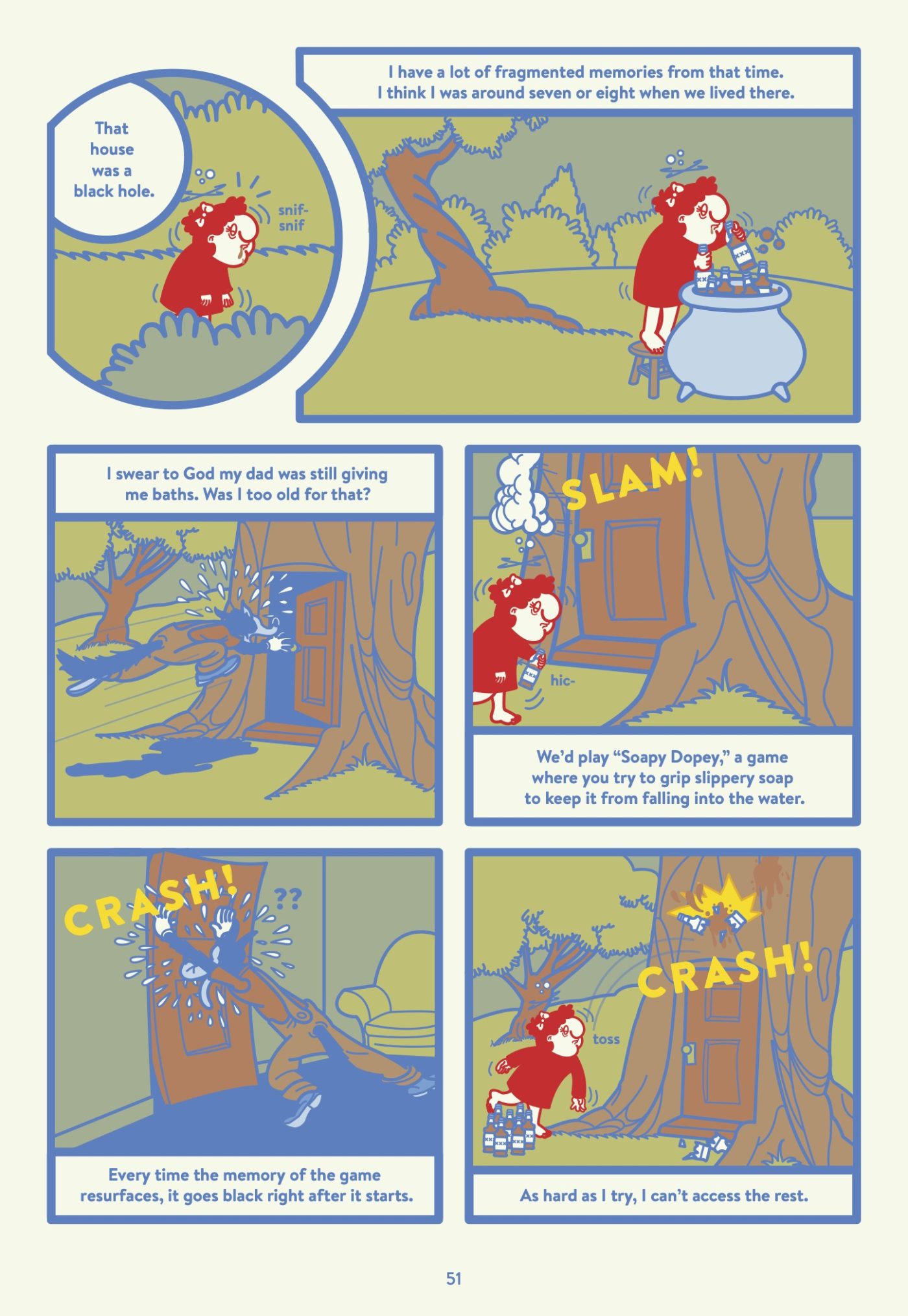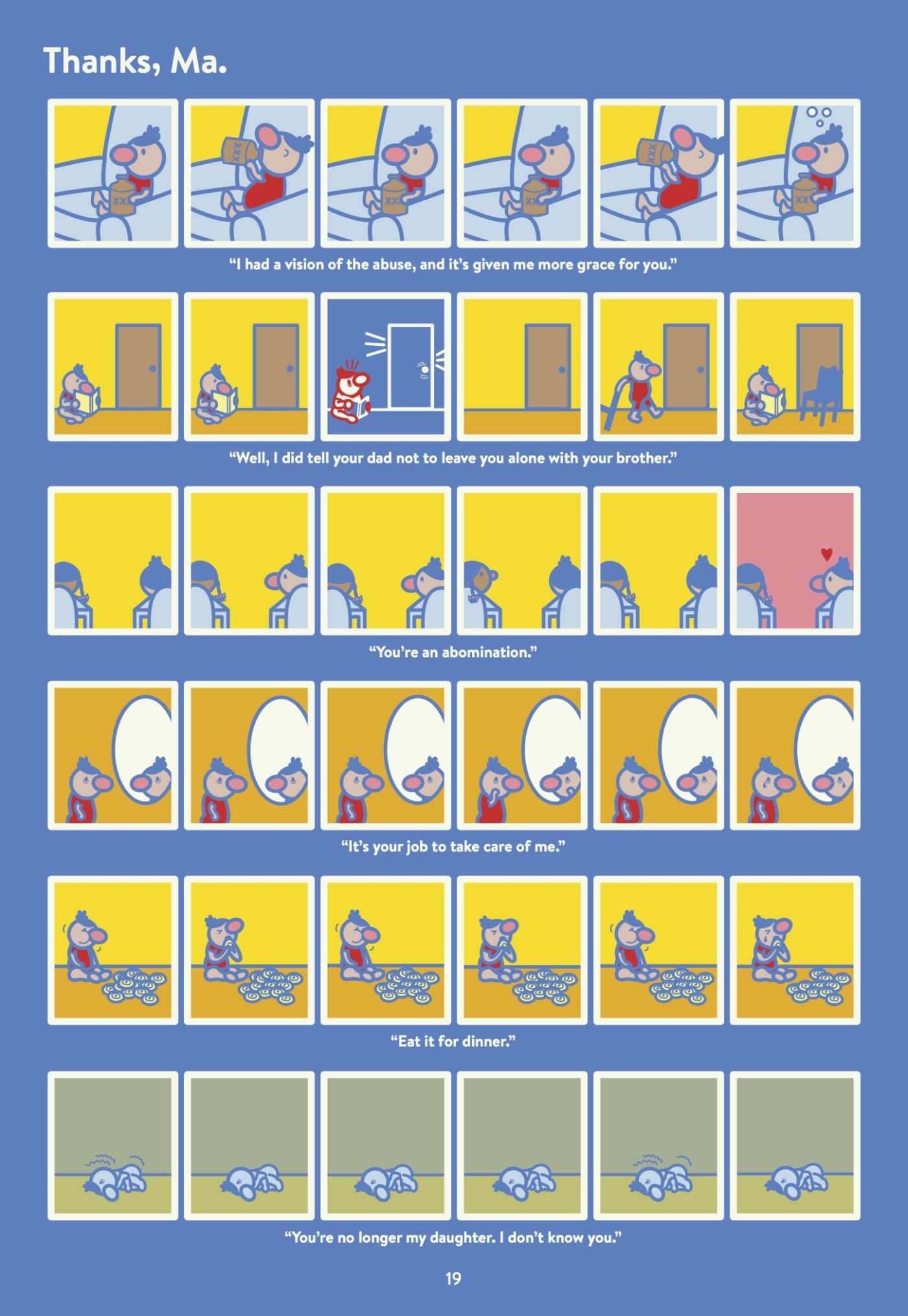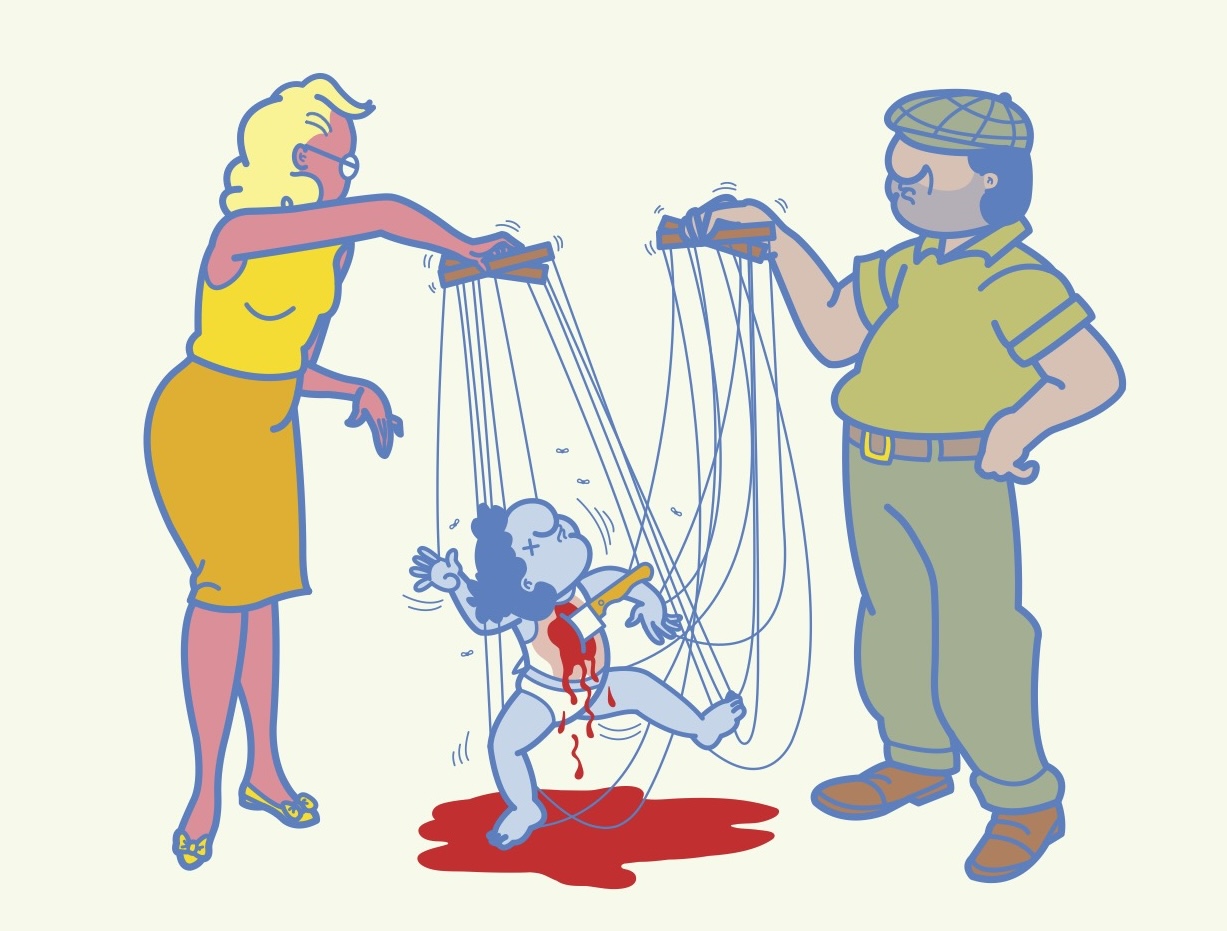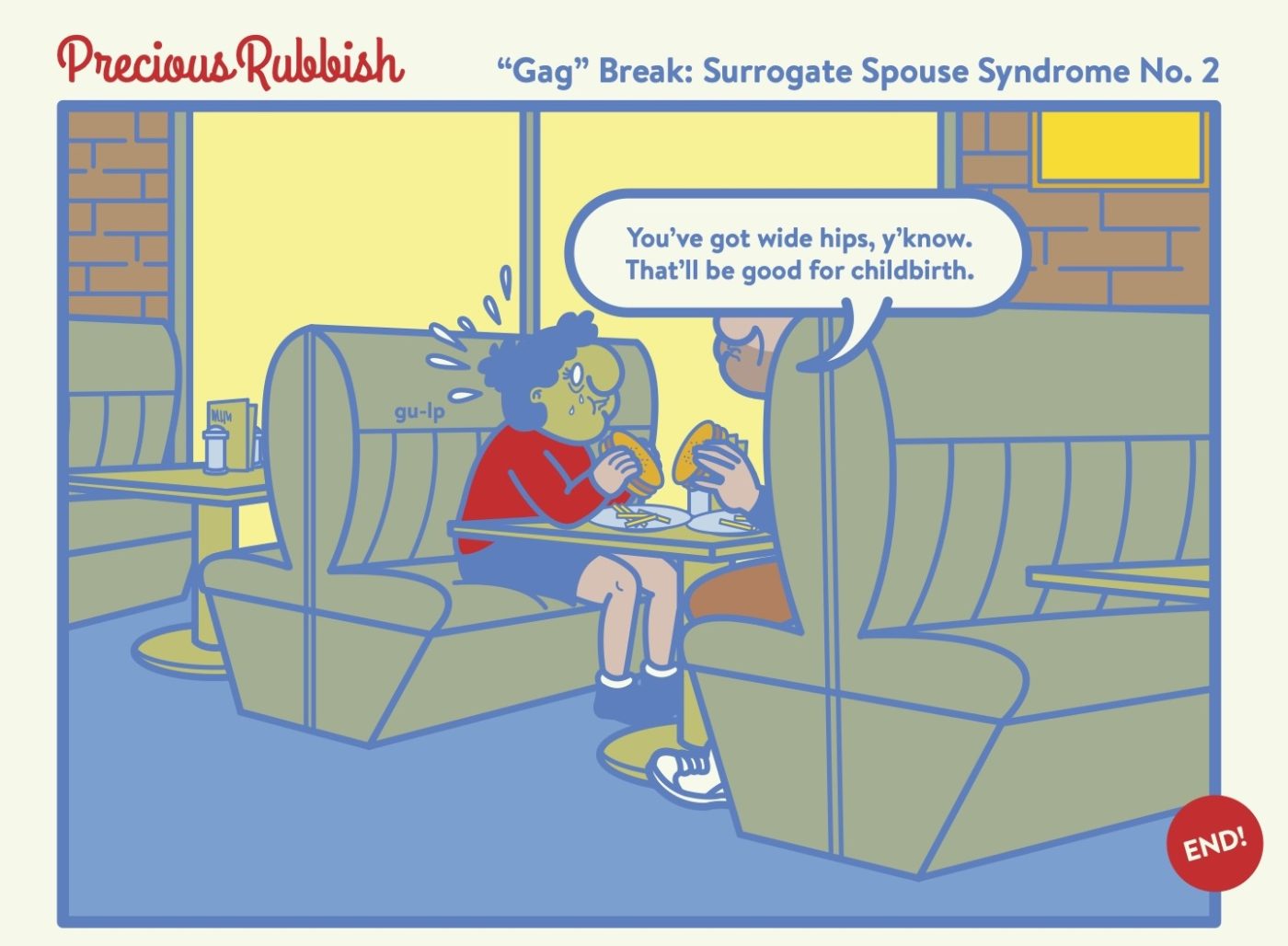So did anyone get the number of that bus that hit me? Oh, wait, that wasn’t a bus, that was Precious Rubbish by Kayla E.
My goodness, but this book is certainly a lot! Thankfully, The Journal already conducted an interview with the author here back in June, a conversation between her, John Kelly, and Mark Newgarden. That feature does an admirable job of covering the most pertinent bases, all the stylistic referents and personal touchstones. Saves me the trouble, really, of doing more than alluding to acknowledged debts towards Chris Ware and Ivan Brunetti. I mean, Kayla E. mentions going out to dinner with them both while on her book tour. And let’s be fair here, in plain terms: you’d mention it too, if it happened to you. No hate. We’re all about love.
So, yes, she’s done the press. The book has already received its laurels in The New York Times and The New Yorker. That used to be an unusual thing, but now it’s just a beat. Anyway, it’s not like we can hold those reviews against her. It’s good work. It has turned heads for a reason. You’re not in for some kind of contrarian hell-ride, don’t worry! I can’t gainsay anything about Precious Rubbish, but it’s a hard book to hold in your hands nonetheless.

Because when you first hold the book? It’s a nice-looking object! A real triumph of the book design arts. I wonder what she does for a living? Oh, she designs books. Well, that makes sense. She’s been nominated for Eisners for that design work, on the Bill Ward: Fantagraphics Studio Edition. Perforce, she works for Fantagraphics, which also feels like a necessary admission for the pages of The Journal. Of course, so do I! I’ve been pulling a paycheck from Fantagraphics for two and a half decades, on and off, which is more than most of you jokers can say. It’s a perfectly normal situation for Fantagraphics to publish reviews of Fantagraphics books produced by Fantagraphics employees, which sounds sarcastic but is merely a fact of life. A staple of comics hypocrisy discourse since longer than you’ve been alive, statistically speaking.
All of which is to say: there’s a reason they hired her to put together books. You can’t but hold Precious Rubbish in your hand to recognize its maker as a prodigy. Even The New York Times could see it.
Still: it’s a hard book to hold in your hands. A rough experience to hold in your head.
Enough so that I admit I’ve put it down a number of times. It’s hard to read more than a few pages at once, and not just because of the subject matter. It’s a visually and thematically dense book, defined by constant allusion, as well as ample recourse to the Bible. Job is especially entailed. The author has been kind enough to annotate her references, revealing a deep engagement with the visual language of midcentury kids comics — Archie and Little Dot and the like. Stuff that not everyone is going to be intimately familiar with, so footnotes are appreciated. The book is steeped in an elemental visual language of comics, generic to an exaggerated degree. Seamless in the manner of vintage advertising illustration. It broadcasts a degree of technical precision that seems in the first place to be Brobdingnagian.
(Speaking of which, since we’re here in the neighborhood — wither is the lack of a backlist trade publishing presence for Archie? There’s no reason they couldn’t be printing thick compendiums of classic era material for legions of adoring readers — pre-DeCarlo, even, the exact same era of stories alluded throughout Kayla E.’s pages. It sparks the imagination even through the reflection of homage. An influence that doesn’t feel completely chewed over even as we recognize its ubiquity.)

Because Precious Rubbish is, we can never forget, another heir to the technical obsession of Ware’s peculiar tendency. We can look back now and see, with rather strikingly crystalline clarity, that Ware proved to be the greatest single influence of his particular cohort of cartoonist, with a stylistic shadow that extends from Hollywood to mainstream superhero comics. There would be no Achewood without Chris Ware. Ware was the house artist to an era of American literary history. As it turns out, he just happens to also be a hell of an artist, and he’s released a lot of material that doesn’t look much like Jimmy Corrigan at all. Me, I love the sketchbooks, the only place you get to see him drawing freehand, so to speak. Absolutely wonderful drawings, impeccable. He could have had an entire career doing books that look like that. But he clearly also enjoys building himself progressively smaller boxes in which to sit in a stress position for a significant amount of time. It’s not like he isn’t that good, because he so clearly and unambiguously is.
He’s in a lot of what gets made now, just by virtue of being a central presence in the artistic life of a generation of cartoonists. I even wrestled with the man for a spell, a few years back. In any event, you can hardly bewail the influence since the sincere attempt to replicate native virtuosity will often inflate the student’s vigor. You can see it in the evolution of Neal Adams into Bill Sienkiewicz, and Socrates into Plato. It’s a fundamental rite of passage for every artist to digest their influences in public. It’s not like Ware sprang fully-formed from the head of Zeus. Frank King and Richard McGuire are both people who either existed or continue to exist. They just made a movie out of Here, for goodness’ sake.
But there’s Brunetti as well. A man who knows a lot about making abrasive comic books. Go back and read the first few issues of Schizo sometime, after you’ve had a stiff drink. Ran across one in a store recently, flipped through — a remarkably bitter draught, thoroughly violent. I respect it, but in hindsight the work of a howling animal. He thankfully outgrew the venting of that compulsively negative internal monologue and trended in a direction of increasing astringency. He feels Ware’s event, deeply, just as deep in his gut Brunetti believes Quimby the Mouse is better than Jimmy Corrigan. Which I know because he whispered it to me in gym class. OK. I lied. He didn’t whisper anything to me in gym class. I’m projecting. I’ve never met the man, because I’m a hermit and I’ve never met anyone. But you know I’m right.
Anyway. Precious Rubbish is also unavoidably abrasive, a torturous progress because that is precisely what the book portrays: the systematic torture of a small child, under the star of the most hellacious personal misfortune and abuse. What’s more, it's a memoir. That’s why there’s no real shape to the narrative, per se, because there is no narrative. There’s the length of a childhood, from very young to young adulthood, defined by a succession of traumatic experiences all the way down, one damnable thing after another. Things are bad for many different reasons. Two people were criminally incompetent as parents and their daughter paid for that shortcoming in just about every way a child can pay. On top of that the world is full of bigots of every stripe.

There’s a spot illustration on the back cover of the book that gives the conceit, an image adapted from Archie’s Girls' Betty and Veronica #59. Baby Kayla is suspended by string held to a marionette controller, only the child is also stabbed in the chest with a kitchen knife. The original image, by Bob White, featured Betty & Veronica holding Archie up on strings. “Let go, Ronnie!” Betty says, “you’ve had Archie on a string long enough!”
Precious Rubbish is a book about processing personal trauma through obsessive art practice. There is no substitute for the hard work necessary to produce the images in this book. Nothing here was cast off in a moment. The visual conceit is fully formed on every page, every fake advertisement and Archie pin-up transformed into excoriating personal testimony. She had to live with these ideas, ruminate on them at length, for the pages of this book to look as good as they do. There’s a lot of them, too — 170 pages, not counting the backmatter, originally serialized in various self-published pamphlets, with the balance appearing in assorted comics anthologies and literary magazines. Clearly Kayla E. found the exercise salutary.
I mean, the book’s been out for a while. A lot of people have already seen the material in this finished version, on top of years leading up to this release in serialization. We can say, rather definitively, that the book was a hit, at least with readers. The material adds up to a wallop, all together in a pile like this. You need to pace yourself, as I say, because it’s pretty dense. You need to really study it to get what’s going on. And it’s a particularly harrowing story to unfold on the way there. A real firecracker in your hands.
There’s a proud tradition of pulling all the nasties out of your head and pinning them down onto the page or the canvas, like exotic insects at the museum, before moving on from the exhibit. Hopefully the museum stays closed. Kayla E. appears to be living her best life in any event, and good for her. It’s not uncommon in 2025 for people to splay the most revealing and intimate details of their private trauma for public consumption. Sometimes it’s even worth it. It can be a remarkably purgative sensation, to take the worst thing you’ve ever felt and fling it into the world for other people to chew on for a while.

This doesn’t feel like needless rumination. This strikes me as an exorcism. Don’t let the technical virtuosity fool you! Don’t hold the skill against her, or worse, mistake it as some hollow technical exercise. This is angry material, at its core, comics as litany, a formal repetition of grievances from the aggrieved to an uncaring universe. Precious Rubbish is a story of serious moral dimension, personal memoir shaped as theodicy — the author’s own term within the text. (That’s her using a fancy word to impress you, don’t look at me like that.) On the face of it the book makes a bold claim, purporting to be a story of growing up framed as a petition on the nature and existence of evil, often in explicitly religious terms. God is very far away from here and the absence is noted.
For all the intense interpersonal harm chronicled herein, for the crowd of uncaring, resentful, or hateful faces who surround our main character, the overwhelming emotional tone throughout is loneliness. A child is suffering and the earth beneath her feet is very cold. This is a book to make you question the decisions you have made in your life, which is the best you can hope for from any kind of book in this fallen world.
Well, I’ve chewed, Lord I’ve chewed. You should too, if you haven’t already. I know it’s been out for a while. I let the other outlets go first, out of courtesy. It’s a book made for holding in your hand and lazily flipping, despite the subject matter. As I say, a credit to the bookmaker’s art. It’s printed on the most remarkably thick high-gloss stock. Under normal circumstances the worst possible kind of paper for high-dollar comic books, because most work isn’t designed to be seen that way. Precious Rubbish was built to replicate the gloss of a vintage newsstand cover stock, impossibly bright and perfect. It’s supposed to look like that, down to every last immaculate detail. A tiny little window onto a world of wonder, so much cleaner than our own.
The post Precious Rubbish appeared first on The Comics Journal.

No comments:
Post a Comment